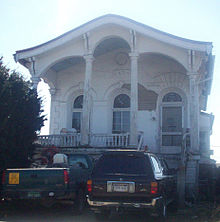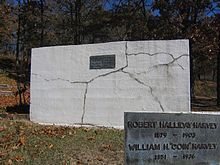- William Hope Harvey
-
 William Hope Harvey
William Hope Harvey
 William Hope Harvey before 1895.
William Hope Harvey before 1895.
William Hope "Coin" Harvey (16 August 1851 – 11 February 1936) was an American teacher, businessman, author, and politician best remembered for his views and his book on bimetallism and the health resort he built in Northwest Arkansas, Monte Ne. His enthusiasm for silver money was later incorporated into the both the Democratic and the American Populist Party in the early 1890s.
Contents
Childhood
He was born in Buffalo, West Virginia on August 16, 1851, the fifth child of six born to Robert and Anna Harvey. His father, Robert Trigg Harvey, was a Virginian of Scottish and English ancestry, and his mother, who had Virginian ancestors traceable to colonial times, was descended from French ancestors who had long since peopled the territory around nearby Gallipolis, Ohio.
Almost nothing is known of William Harvey's childhood except that it was disturbed by conflict between the Unionist majority in his region and secessionist sympathizers, among whom were some of his paternal relatives. He had one sister who joined a convent and a brother who died under the command of Robert E. Lee in the American Civil War.
Education
He was educated at the Buffalo Academy. At the age of 16 he taught school for three months. He then attended Marshall College at Guyandotte, Virginia for three months. At the time the college was teaching mostly secondary subjects. Then at age 17 he taught school for another three months. Afterward he ended his formal teaching and education, however he continued studying law with his brother Thomas, who would go on to graduate from Washington College with a Bachelor of Law.
Law practice
With only the most basic knowledge of law, Harvey managed to pass the necessary tests to be admitted to that bar in West Virginia. He then opened up a law practice in Barboursville, and was relatively successful. He had a good court appearance being slender, five foot ten, erect bearing and penetrating blue eyes. He was soon practicing law in Illinois and Ohio.
Early in his career, he took a case that no other attorney would. He defended a white man who married an African American woman, which was against the law in West Virginia. To close his defense Harvey asked, "Can anyone in this courtroom prove that this man has not a drop of colored blood in his veins." The case was dismissed.
Another case he had seems to have profoundly impacted him for the rest of his life. Harvey was representing a wealthy client who was the victim of a murder. From then on he mistrusted great wealth. He developed a strong belief in the coining of money with silver at 1/16 the cost of gold. This would increase employment in silver mines and bring people out of debt. He hated usury, and the practice of charging interest on loans. These views earned him the nickname "Coin".
Family
Three years after opening his law practice, Harvey moved to Huntington, West Virginia and became law partners with his brother Thomas. Then in 1873 he moved forty miles to Gallipolis. Here he met Anna Halliday and they were married June 26, 1876. Later that year they moved to Cleveland. While they were living there they had two children: Mary Hope and Robert Halliday. Then in 1879 the moved to Chicago where they had a third child Thomas William. Finally in 1881 the Harveys moved back to Gallipolis.
Harvey was the campaign manager for William Jennings Bryan's 1896 Presidential run. Bryan lost 271 to 176 in the electoral college.
Robert had obtained a job as brakeman on the Frisco Railroad in 1903. He had been a law student in Chicago when Harvey bought Monte Ne. Robert received word that he was being appointed to the Railway Mail Service. Two days later he was on his last trip on a freight train as a brakeman when his train was wrecked and he was killed. He was interred in a concrete mausoleum in Monte Ne.
Harvey established the Ozark Trails Association to promote good roads, highway markers, and maps. Although his main interest was promoting travel to Monte Ne, in southwest Missouri and across Oklahoma, the Texas panhandle, and on into New Mexico. Much of this route became the famed U.S. Route 66.
In his later years, as Monte Ne began to sink into debt and his health began deteriorating, he believed that human civilization was on the verge of collapse. He began making plans to build a giant obelisk, although he referred to it as 'The Pyramid'. It was serve as a time capsule for future humans to see what society had been like at its peak. Although some preliminary work on the Pyramid was done, Harvey became preoccupied with building an amphitheater which used up most of his funds and after the stock market crash of 1929 all work at Monte Ne ceased and the Pyramid was never constructed.
In 1932 Harvey formed the Liberty Party based on his financial theories.
Books and writings
- Coin's Financial School (1893)
- A Tale of Two Nations (1894)
- The Patriots (1895)
- Coin on Money, Trusts, and Imperialism (1899)
- The Remedy (1915)
- Common Sense (1920)
- Paul's School of Statesmanship (1924)
- The Book (1929)
- Coin's Financial School Up To Date
- Common Sense, Or The Clot On The Brain Of The Body Politic
External links
- Restoring the Historic Coin Harvey House of Huntington, West Virginia at coinharvey.com
- AmericanHeritage.com / William Hope Harvey at www.americanheritage.com Entry at AmericanHeritage.com
Categories:- 1851 births
- 1936 deaths
- People from Putnam County, West Virginia
- People from Huntington, West Virginia
- People from Benton County, Arkansas
- Activists from West Virginia
- American economics writers
- American pamphlet writers
- United States presidential candidates, 1932
- Deaths from peritonitis
- Educators from West Virginia
- Businesspeople from West Virginia
- Writers from West Virginia
- West Virginia lawyers
Wikimedia Foundation. 2010.


